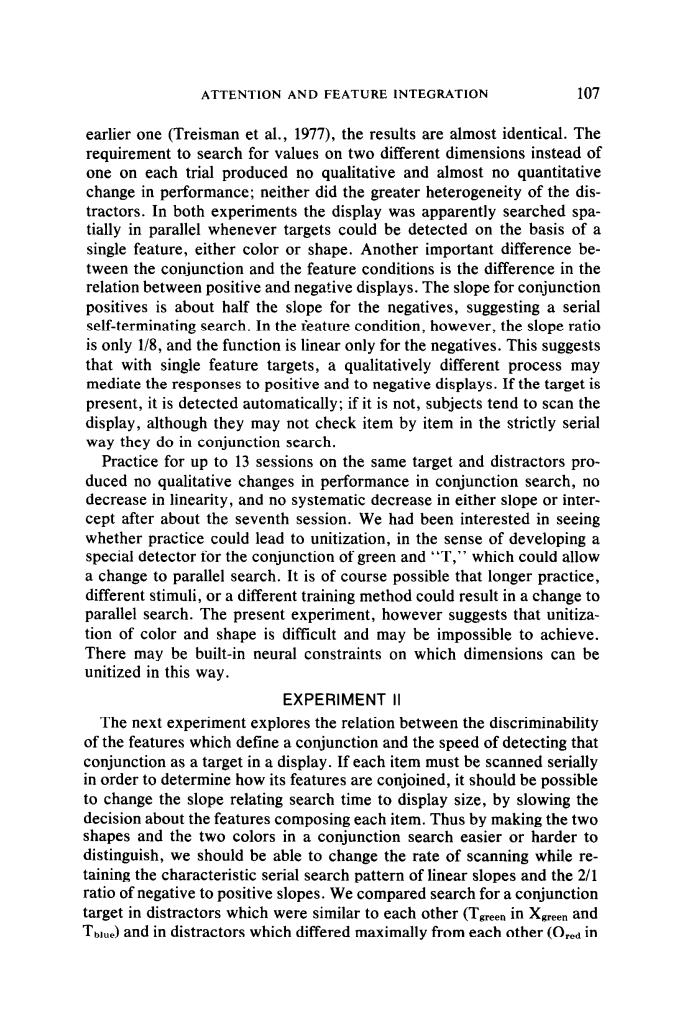正在加载图片...

ATTENTION AND FEATURE INTEGRATION 107 earlier one (Treisman et al.,1977),the results are almost identical.The requirement to search for values on two different dimensions instead of on each trial produced no ualitative and almost no quantitative change in performance:neither did the greater heterogeneity of the dis tractors.In both experiments the display was apparently searched spa- tially in parallel whenever targets could be detected on the basis of a single feature,either color or shape.Another important difference be- tween the conjunction and the feature conditions is the difference in the relation betw ositive and negati splays .The slope fo positives is about half the slope for the negatives,suggesting a seria self-ferminating search.In the reature condition.however.the slope ratio is only 1/8,and the function is linear only for the negatives.This suggests that with single feature targets,a qualitatively different process may nediate the Po itive and to n eg If the ta arget present,it is etected automaticlly:if tend to scan the display,although they may not check item by item in the strictly serial way they do in conjunction search. Practice for up to 13 sessions on the same target and distractors pro duced no alit tive cha nges in perfo ma ance in nction search. e in ty,and no se in eit or inter cept after about the seventh session.We had been interested in seeing whether practice could lead to unitization,in the sense of developing a special detector for the conjunction of green and''T,"which could allow a change to parallel search.It is of course possible that longer practice, different stimuli,or a different training method could result in a cha to parallel se rch.The present however sugges that un tion of color and shape is difficult and may be impossible to achieve There may be built-in neural constraints on which dimensions can be unitized in this way. EXPERIMENT II The next experiment explores the relation between the discriminability of the features which define a conjunction and the speed of detecting that coniunction as a target in a display.if each item must be scanned serially in order to determine how its features are conjoined,it should be possible to change the slop relating search time size,by slowi ing the decision displa L features composing each item.Thus by making the tw pes and the two colors I in a conjunction search easier or harder to distinguish,we should be able to change the rate of scanning while re- taining the characteristic serial search pattern of linear slopes and the 2/1 ratio of negative to positive slopes.We compared search for a conjunction target in distractors which were similar to each other(T in X and )and in distractors which differed ma mally from ea ch othe (0 in ATTENTION AND FEATURE INTEGRATION 107 earlier one (Treisman et al., 1977), the results are almost identical. The requirement to search for values on two different dimensions instead of one on each trial produced no qualitative and almost no quantitative change in performance; neither did the greater heterogeneity of the distractors. In both experiments the display was apparently searched spatially in parallel whenever targets could be detected on the basis of a single feature, either color or shape. Another important difference between the conjunction and the feature conditions is the difference in the relation between positive and negative displays. The slope for conjunction positives is about half the slope for the negatives, suggesting a serial self-terminating search. In the ieature condition, however, the slope ratio is only l/8, and the function is linear only for the negatives. This suggests that with single feature targets, a qualitatively different process may mediate the responses to positive and to negative displays. If the target is present, it is detected automatically; if it is not, subjects tend to scan the display, although they may not check item by item in the strictly serial way they do in conjunction search. Practice for up to 13 sessions on the same target and distracters produced no qualitative changes in performance in conjunction search, no decrease in linearity, and no systematic decrease in either slope or intercept after about the seventh session. We had been interested in seeing whether practice could lead to unitization, in the sense of developing a special detector for the conjunction of green and “T,” which could allow a change to parallel search. It is of course possible that longer practice, different stimuli, or a different training method could result in a change to parallel search. The present experiment, however suggests that unitization of color and shape is difficult and may be impossible to achieve. There may be built-in neural constraints on which dimensions can be unitized in this way. EXPERIMENT II The next experiment explores the relation between the discriminability of the features which define a conjunction and the speed of detecting that conjunction as a target in a display. If each item must be scanned serially in order to determine how its features are conjoined, it should be possible to change the slope relating search time to display size, by slowing the decision about the features composing each item. Thus by making the two shapes and the two colors in a conjunction search easier or harder to distinguish, we should be able to change the rate of scanning while retaining the characteristic serial search pattern of linear slopes and the 2/l ratio of negative to positive slopes. We compared search for a conjunction target in distracters which were similar to each other (TBreen in X,,,,, and Tbiue) and in distracters which differed maximally from each other (Ored in